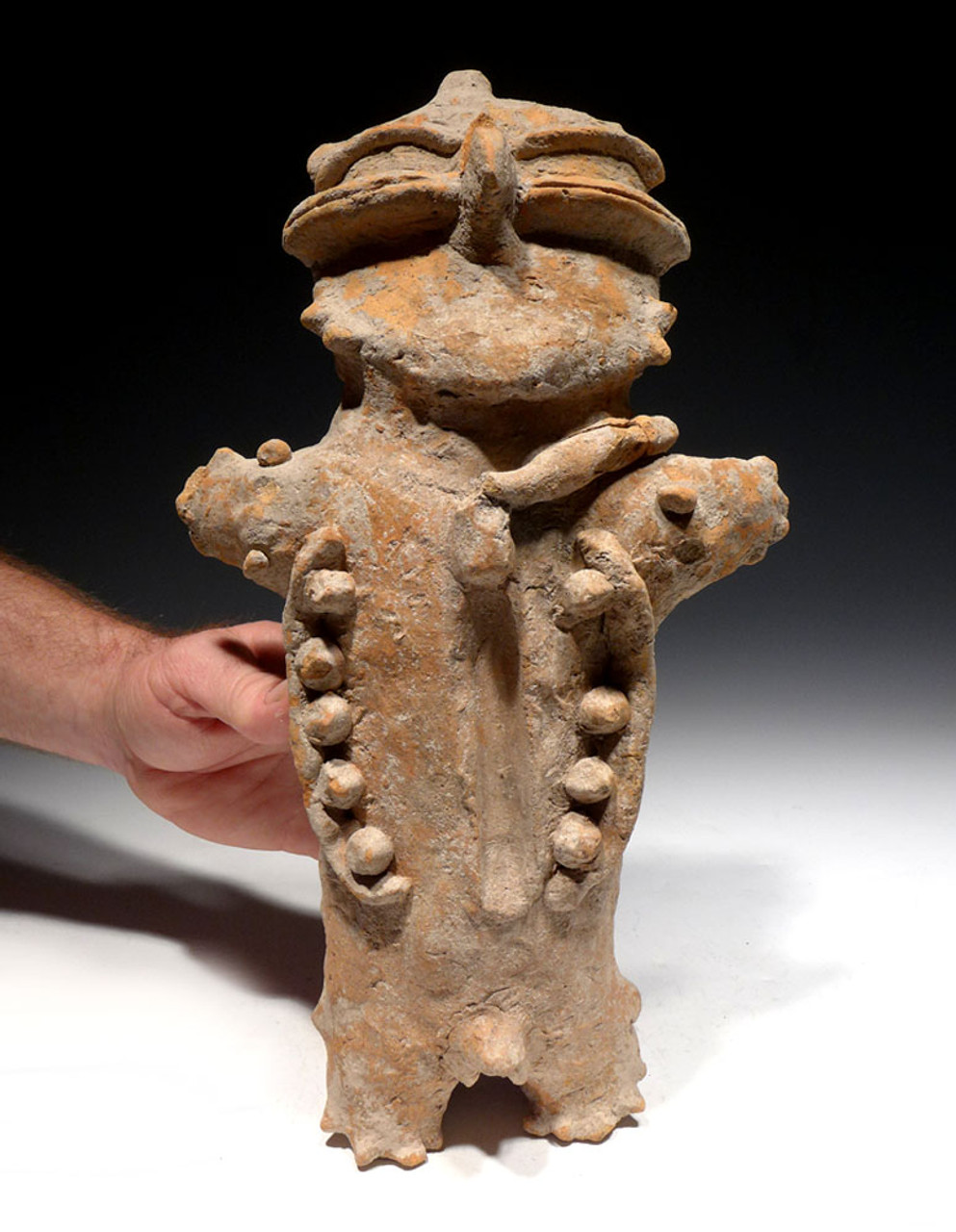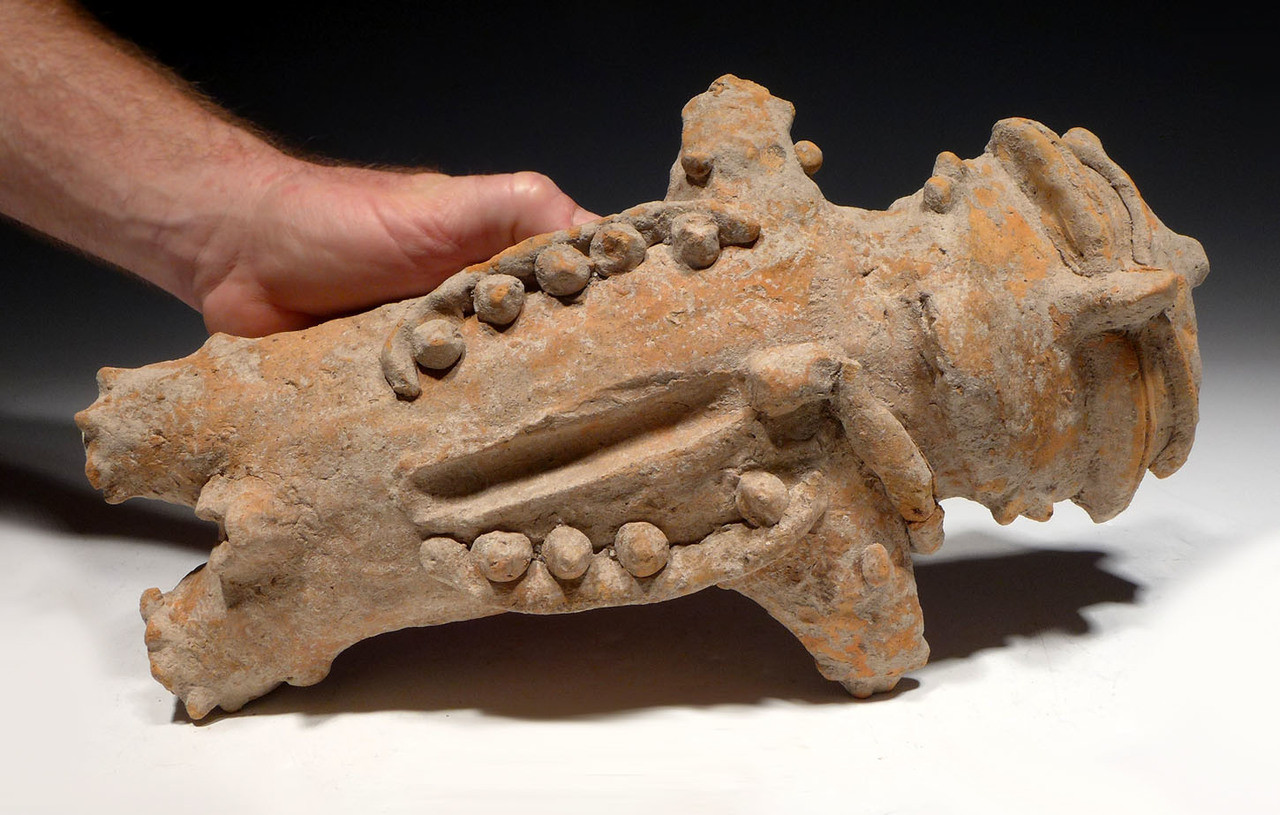Product Description
Human figures from the mysterious Pre-Columbian Mezcala culture, are the most well-known objects they left behind. This unusual figure is EXTREMELY RARE in many ways. It is made of ceramic, not stone, is unusually large (larger than their stone figures) and finally and most notably, depicts in graphic detail, a human male sacrifice victim that has his chest cut and spread open. NONE of the typical Mezcala stone figures ever depict human sacrifice. As a matter of fact, in all the thousands of pieces we have seen and handled in the last 33 years as well as what we have seen in museums, we have never encountered such a more obvious and graphic example of human sacrifice displayed in Pre-Columbian craft, as this rare object.
The famous practice of cutting open the chest with a bifacial stone dagger and removing the heart is displayed here, after the fact, with nothing left to the imagination. The head shape and fare are classic Mezcala in form and style. Arms and feet show strained extension of fingers and toes with arms and legs spread out. As stylized as Mezcala art is, this figure shows detail beyond the norm. Based on the size of this figure and its subject matter, it is probable that this was intended for display in a human sacrifice temple or place of worship, and not a personal use object. The fact that the back is flat and unfinished, makes it undeniable that this was meant to be displayed laying flat on its back in the same way the victim in real-life would have laid. This would make an incredible display piece on its own, laying on the display "altar" it comes with. It would also be an incredible centerpiece to an array of bifacial stone knives and blades which would have been the tools used to remove the heart of human sacrifices.
Mezcala figures have a mysterious origin and are one of the most desirable objects of all Pre-Columbian cultures, not only today, but in antiquity. The later Pre-Columbian tribes of the region such as the inhabitants of Teotihuacan, and the Aztecs, went to the trouble of digging them up and interring them into their own temples! The abstract artistic nature of these objects is so unusual and unique that immediately by sight alone, they are recognizable for their culture and region of origin!
HISTORY
The Pre-Columbian Mezcala Culture is a little understood culture that was based in present-day Guerrero, Mexico. A long, complex culture history of the Guerrero region prevents a finite understanding of who exactly made Mezcala objects. The culture is also called Balsas Culture because it is centered in the upper Balsas River drainage region. It is believed the Mezcala style emerged during the Pre-classic Period, between 700-200 B.C. and continued on into Classic Period to 650 A.D..
Objects attributed to the the Mezcala Culture include figurines, masks, small effigies of animals and objects, beads, pendants and earplug flares. They are carved from a variety of green, gray-green, gray and black color hardstones and jade. The art style is so unique that Mezcala objects are readily recognized for their abstract and minimalist anatomical features. Some Mezcala style stone objects show strong Olmec influence. Beautiful stylized masks from Guerrero exhibit Teotihuacan Classic Period influence. Mezcala style objects were excavated by the much later Aztec peoples and revered as sacred objects.
Mezcala style stone carved figurines have a basic petaloid axe form and are sometimes casually labeled "axe gods". Symmetrically arranged cuts in the stone are arranged to resemble facial and body features. Scarcer objects depict human forms in seated or crouching positions. Carved stone masks are found in more diverse forms from abstract to beautifully stylized renderings. Clay figures and pottery are also known but the culture is most famous for its unique carved stone objects.
 US DOLLAR
US DOLLAR
 EURO
EURO
 AUSTRALIAN DOLLAR
AUSTRALIAN DOLLAR
 CANADIAN DOLLAR
CANADIAN DOLLAR
 POUND STERLING
POUND STERLING






















